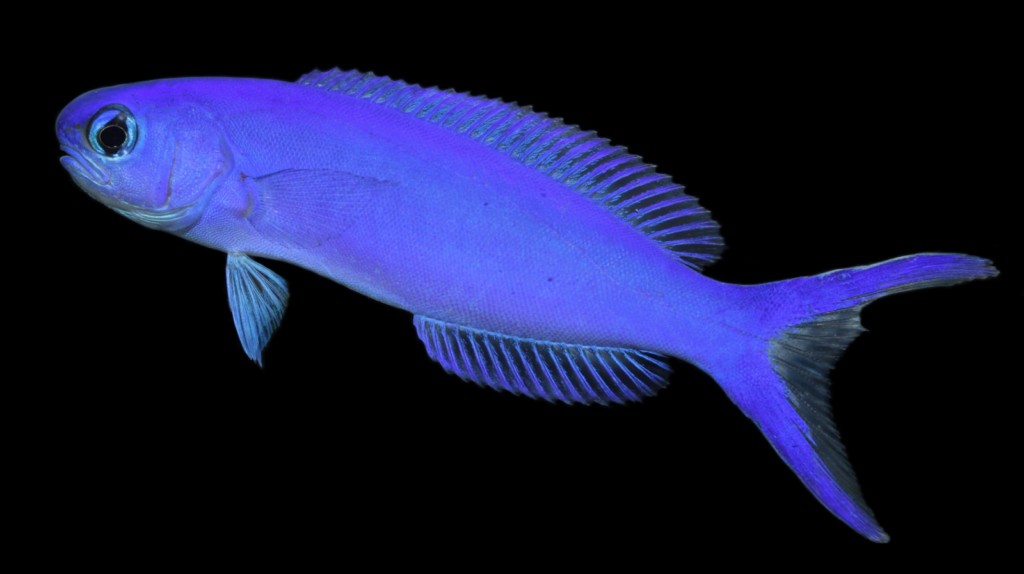HOPLOLATILUS STARCKI - (RANDALL & DOOLEY, 1974)
Picture courtesy of: Nicolas Charpin
Actinopterygii (Gigaclass) > Actinopteri (Class) > Teleostei (Subclass) > Acanthuriformes (Order) > Malacanthidae (Family) > Hoplolatilus (Genus)
Poisson couvreur bleu, Blue tilefish, Blue-head tilefish, Bluehead tilefish, Purple-headed sand tilefish, Starck's tilefish, Stark's tilefish, 斯氏似弱棘鱼, 斯氏似弱棘魚,
Description
Dorsal spines (total): 8; Dorsal soft rays (total): 21-23 (usually: 22); Anal spines: 2; Anal soft rays: 15-16 (usually: 16); Pectoral fin rays: 18-19 (usually: 19); Vertebrae: 10 + 14; Gill rakers: 22-27 (usually: 23). Preopercular serrae: 30-57; Pored Lateral line scales: 100-113 (usually: 108) to hypural crease; Cheek scales: 6-12 (usually: 9); Opercular scales: 7-10 (usually: 9); Scale above lateral line: 12-15 (usually: 14), below: 40-46 (usually: 46). Body long and slender; Caudal fin forked in adults, deeply emarginate in juveniles. Mouth slightly inferior, oblique, maxillary reaching to between posterior rims of pupil and orbit. Mouth hinge fairly broad, about equal to pupil diameter; Upper jaw with 2-3 elongate teeth at anterior margin, 1-2 at posterior margin, and 24-32 teeth intermediate to these along outer margin; Lower jaw with 5-12 enlarged anterior teeth plus 8-11 smaller teeth; 3-4 row of viliform teeth near hpper and lower jaw simphyses. Max. length: 15.5 cm TL. Depth range: 20 - 105 m, usually: 20 - 50 m.
Description
Dorsal spines (total): 8; Dorsal soft rays (total): 21-23 (usually: 22); Anal spines: 2; Anal soft rays: 15-16 (usually: 16); Pectoral fin rays: 18-19 (usually: 19); Vertebrae: 10 + 14; Gill rakers: 22-27 (usually: 23). Preopercular serrae: 30-57; Pored Lateral line scales: 100-113 (usually: 108) to hypural crease; Cheek scales: 6-12 (usually: 9); Opercular scales: 7-10 (usually: 9); Scale above lateral line: 12-15 (usually: 14), below: 40-46 (usually: 46). Body long and slender; Caudal fin forked in adults, deeply emarginate in juveniles. Mouth slightly inferior, oblique, maxillary reaching to between posterior rims of pupil and orbit. Mouth hinge fairly broad, about equal to pupil diameter; Upper jaw with 2-3 elongate teeth at anterior margin, 1-2 at posterior margin, and 24-32 teeth intermediate to these along outer margin; Lower jaw with 5-12 enlarged anterior teeth plus 8-11 smaller teeth; 3-4 row of viliform teeth near hpper and lower jaw simphyses. Max. length: 15.5 cm TL. Depth range: 20 - 105 m, usually: 20 - 50 m.
Color
Small juvenile bright blue.
Adults olive brown on back, shading to yellowish on lower sides; Head and pectoral throat region bright blue; Caudal fin yellow.
Etymology
Hoplolatilus: from ancient Greek, hóplon = shield. Hoplites were citizen-soldiers of Ancient Greek city-states who were primarily armed with spears and shields. Hoplite soldiers utilized the phalanx formation to be effective in war with fewer soldiers + from Latin, latus = wide, broad.
starcki: the species is named in honor of Dr Walter A. Starck, whose collecting efforts, photos, and observations added much to our knowledge of the genus Hoplolatilus.
Original description: Hoplolatilus starcki Randall & Dooley, 1974 - Type locality: outside fringing reef, northwestern Cocos Island, Guam, Mariana Islands, western Pacific, depth: 75 feet.
Small juvenile bright blue.
Adults olive brown on back, shading to yellowish on lower sides; Head and pectoral throat region bright blue; Caudal fin yellow.
Etymology
Hoplolatilus: from ancient Greek, hóplon = shield. Hoplites were citizen-soldiers of Ancient Greek city-states who were primarily armed with spears and shields. Hoplite soldiers utilized the phalanx formation to be effective in war with fewer soldiers + from Latin, latus = wide, broad.
starcki: the species is named in honor of Dr Walter A. Starck, whose collecting efforts, photos, and observations added much to our knowledge of the genus Hoplolatilus.
Original description: Hoplolatilus starcki Randall & Dooley, 1974 - Type locality: outside fringing reef, northwestern Cocos Island, Guam, Mariana Islands, western Pacific, depth: 75 feet.
Distribution
Eastern Indian Ocean and western Pacific: Bali (Indonesia), east to Philippines and New Ireland (Papua New Guinea), south to northern Australia, Solomon Islands and New Caledonia.
Eastern Indian Ocean and western Pacific: Bali (Indonesia), east to Philippines and New Ireland (Papua New Guinea), south to northern Australia, Solomon Islands and New Caledonia.
Biology
Inhabits patches of talus or rubble of steep outer reef slopes. Usually seen in pairs that quickly dive headfirst into their burrow when disturbed. Juveniles occasionally school with similarly colored juveniles of Mirolabrichthys pascalus (Jordan & Tanaka, 1927). It can also be found in the aquarium trade. Stomach contents of 6 adult specimens consisted of copepods (31.4 % by volume), pelagic tunicates (31 %, larvaceans, plus Oikopleura), fish eggs (28.6 %), siphonophores (5.5 %), larval shrimps (1.2 %), fish (0.8 %), amphipods (0.7 %), unidentified decapod larvae (0.5 %), and heteropods (0.3 %).
Inhabits patches of talus or rubble of steep outer reef slopes. Usually seen in pairs that quickly dive headfirst into their burrow when disturbed. Juveniles occasionally school with similarly colored juveniles of Mirolabrichthys pascalus (Jordan & Tanaka, 1927). It can also be found in the aquarium trade. Stomach contents of 6 adult specimens consisted of copepods (31.4 % by volume), pelagic tunicates (31 %, larvaceans, plus Oikopleura), fish eggs (28.6 %), siphonophores (5.5 %), larval shrimps (1.2 %), fish (0.8 %), amphipods (0.7 %), unidentified decapod larvae (0.5 %), and heteropods (0.3 %).
Last update: 2, November 2024
